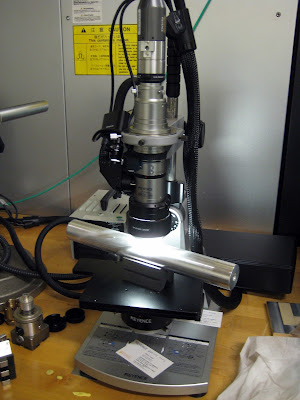As part of a development effort on a new high field magnet design we are currently fabricating various parts of a prototype magnet for testing. The magnet is a hybrid design and uses a unique configuration to cancel and or minimize the some of the large forces that want to rip the magnet apart. We call this unique design a canted cosine theta configuration or CCT for short. This is a hollow bore superconducting design that we hope will lead to magnetic fields in the 20T (Tesla) range. So far the results are promising and fun to work on.
In these shots you see the basic configuration of the magnet. These are parts produced by the FDM process and were used to test groove geometry and winding potential. The cable Jim is inserting is a flat multi strand cable of rectangular cross section approximately 1mm x 3mm.
As you can see in the images the Niobium Titanium cable is insulated with a thin glass sleeve or overwrap. The idea is this isolates the wire from the magnet structure electrically. Part of our development project is to determine the groove geometry that protects the wire and insulation during winding and holds the wire securely during operation. Ultimately these might be built using Niobium-tin (Nb3Sn) which will allow higher magnetic fields to be achieved.
Here is an aluminum test mandrel I machined on a 4th axis CNC machine. This particular sample was for winding and insulation testing for a high temperature superconductor (HTS). It is 1.50 inches (38mm) in diameter and the elliptical helical groove is a little over 1mm wide and 1mm deep with a round bottom. During winding tests the edge of the groove damaged the thin insulation so we tried a few quick shop fixes to try and soften the edge.
To help evaluate the changes in groove geometry we used a special digital microscope made by the Keyence company. We have one of these wonderful tools that we can use to examine and measure small features like this groove.
The microscope itself was designed from the outset to be portable and stand alone. The idea was to put an advanced tool out on the shop floor to collect meaningful information with the parts in situ. The variety of lenses allow the user to capture and measure with high magnification and great depth of field. The computer is fully ruggedized and integrated and easily portable with the actual scope. The stage is motorized and allows the computer to control the focus and depth up measuring feature. We didn't use the tilting ability of the stage for what we did here but it has been handy to create three dimensional images or peer into something off axis.
On the mandrel one thing we tried in the shop to gently deburr and soften the edges of the wire groove was wire brushing with a soft bristle wire wheel. The thought was that the bristles would break down the edge and not disturb the groove much.
In this image you can see the effect of the wire brush on the groove. The surface has been roughened by the brush. Unfortunately I didn't get any images before we brushed the mandrel.
Drilling down further at higher magnification we see the edges and lizard skin surface in better detail.
The microscope has a variety of measuring tools for distance, diameter, area etc. One of the more amazing things it can do is three dimensional images. The Keyence VHX does this by taking a set of images depth up and combining them to produce a three dimensional image that can be rotated much like a solid model.
The groove surface and top are both in focus giving a depth of field in this case of around a millimeter at 50x magnification. Images can be stitched together to make a larger seamless mosaic.
This is a three dimensional image of the curved pole section of the test mandrel.
The second thing we tested with this mandrel was a chemical etch to help soften the insulation scuffing corners. It consisted of an acid etch, much the same as a pre-anodizing treatment but without the caustic part of the anodizing process.
In this image you can see the overall improvement of the wire brushed surface in the earlier image.
Link to some other images taken with the VHX system.
Thanks for looking.
Tom Lipton











Tom, You do some truly interesting work. Once again thanks for sharing.
ReplyDeleteHi Tim,
DeleteThanks for the comment. The work is the juice for me.
Best,
Tom
Every home workshop should have one, do you have the Harbour Freight catalogue no ? ;-)
ReplyDeleteMike
Hi Mike,
ReplyDeleteIt will be awhile before HF carries these babies. The base unit with the standard lens is $50K USD
Thanks for the comment.
Best,
Tom
Blown away, as usual!
ReplyDeleteSure beats the stuff I do, but not sure if I would want to even TRY doing what you do...
Keep 'em coming Tom.
Hi Ian,
DeleteThanks for the comment. Just follow my two basic rules of work,
1. Fake it till you make it.
2. Always do what you love to do.
Optional rule 3, Better dead than look bad.
Regards,
Tom
Pocket change.... lol.....
ReplyDeleteWant one for your very own?
ReplyDeleteCheck out this youtube:
http://www.youtube.com/watch?v=lw1b58kITxQ
nike air max
ReplyDeleteoffwhite
yeezy boost
converse outlet store
adidas yeezy
nike max
westbrook shoes
kobe shoes
louboutin shoes
nike air force
kyrie 5 shoes
ReplyDeletemichael jordan shoes
golden goose
hermes handbags
curry 5 shoes
retro jordans
curry 8
supreme clothing
jordan shoes
supreme new york